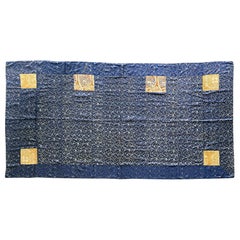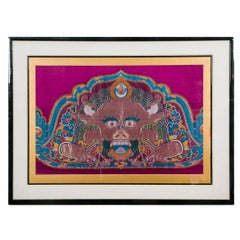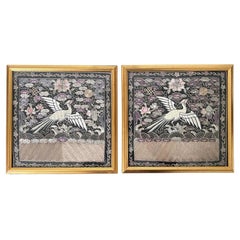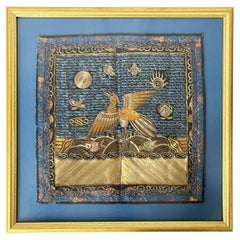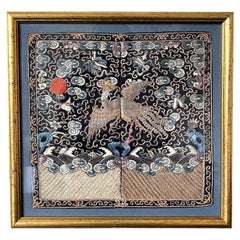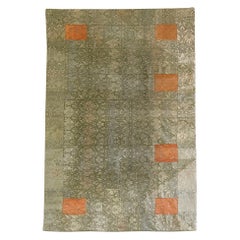TISHU Wall Decorations
to
4
284
236
41
7
Height
to
Width
to
99
5
2
2
1
1
31
89
116
48
24
34
45
3
1
1
2
2
11
9
9
12
16
184
115
96
94
37
134
129
71
68
55
284
284
284
8
7
6
6
5
Japanese Monastery Robe Patchwork Kesa with inscription Edo Period
Located in Atlanta, GA
A Japanese Kesa (Monk's Vestment) made from fourteen columns of patchworks of blue brocades with sumptuous woven pattern. The elaborate motifs feature re...
Category
Antique Early 19th Century Japanese Japonisme Textiles
Materials
Brocade, Silk
Framed Tibetan Woven Silk Kesi Panel of Kirtimukha
Located in Atlanta, GA
A woven silk Kesi panel depicts Kirtimukha from Tibet circa the second half of 20th century. Beautifully woven from short weft silk with superb coloring and ...
Category
20th Century Tibetan Tibetan Textiles
Materials
Silk
Pair of Framed Chinese Embroidered Ninth Rank Badges Qing Dynasty
Located in Atlanta, GA
On offer is a matching pair of embroidered silk civil rank badge panels (known in Chinese as Buzi) in black lacquer frames. The panels feature a black background within a scrolling floral border. In the center, it showcases a winged paradise fly catcher...
Category
Antique Late 19th Century Chinese Chinoiserie Textiles
Materials
Silk, Giltwood
Framed Fine Embroidered Second Rank Badge Chinese Qing Dynasty
Located in Atlanta, GA
A finely embroidered silk civil rank badge panel presented in a giltwood frame circa mid-late 19th century. The square rank badge is known in Chinese ...
Category
Antique 19th Century Chinese Chinese Export Textiles
Materials
Silk
Framed Fine Embroidered Fifth Rank Badge Chinese Qing Dynasty
Located in Atlanta, GA
A finely embroidered silk civil rank badge panel presented in a giltwood frame circa mid-late 19th century. The square rank badge is known in Chinese ...
Category
Antique 19th Century Chinese Chinese Export Textiles
Materials
Silk
Antique Japanese Brocade Monk's Robe Kesa Meiji Period
Located in Atlanta, GA
A Japanese Kesa (Monk's Vestment) made from thirteen columns of patchworks of shimmering woven brocades. The elaborate motifs feature repetitive elaborat...
Category
Antique Late 19th Century Japanese Meiji Textiles
Materials
Brocade, Silk
Fine Korean Embroidered Military Rank Badge Joseon Dynasty One of the Pair
Located in Atlanta, GA
A Korean embroidered silk rank badge (Hyungbae in Korean) from late Joseon Dynasty circa t19th century. One of a fine matching pair, the badge featu...
Category
Antique 19th Century Korean Other Textiles
Materials
Fabric, Silk, Wood
Fine Korean Embroidered Military Rank Badge Joseon Dynasty One of the Pair
Located in Atlanta, GA
A Korean embroidered silk rank badge (Hyungbae in Korean) from late Joseon Dynasty circa t19th century. One of a fine matching pair, the badge features des...
Category
Antique 19th Century Korean Other Textiles
Materials
Fabric, Silk, Wood
Korean Embroidered Military Rank Badge Joseon Dynasty
Located in Atlanta, GA
A Korean embroidered silk rank badge (Hyungbae in Korean) from late Joseon Dynasty circa the end of 19th century. The badge features a design of double leop...
Category
Antique Late 19th Century Korean Other Textiles
Materials
Fabric, Silk, Wood
Australian Aboriginal Carved and Painted Spear from Melville Island
By Patrick Freddy Puruntatameri
Located in Atlanta, GA
Title: A ceremonial spear with clan design paint
Artist: Patrick Freddy Puruntatameri
DOB: 19/04/1973
Medium: Ocher paint on ironwood carving
DOC:...
Category
Early 2000s Australian Folk Art Wall-mounted Sculptures
Materials
Wood
Australian Aboriginal Carved and Painted Spear from Melville Island
Located in Atlanta, GA
Title: A ceremonial spear with clan design paint
Artist: John Martin Tipungwuti
DOB: 18/01/1969
Medium: Ocher paint on wood carvin
DOC: 2006
Provenance: COA from Jilamara Arts a...
Category
Early 2000s Australian Tribal Wall-mounted Sculptures
Materials
Wood
Australian Aboriginal Yawkyawk Fiber Sculpture
By Allison Guwanjguwanj
Located in Atlanta, GA
Fiber art by contemporary aboriginal artist
Allison Guwanjguwanj. It depicts a dreamtime creature called "Yawkyawk" which is the ancestor of the cl...
Category
Early 2000s Australian Tribal Wall-mounted Sculptures
Materials
Natural Fiber
Framed Antique Japanese Embroidery Fukusa Panel
Located in Atlanta, GA
A finely embroidered Japanese silk Fukusa panel presented in a beautiful brocade-wrapped fame. Circa late 19th century of Meiji Period, Fukusa is a traditional Japanese textile...
Category
Antique Late 19th Century Japanese Meiji Textiles
Materials
Silk, Wood
Japanese Brocade Noh Costume Kimono Robe Meiji Period
Located in Atlanta, GA
A Noh costume made from magnificent silk twill brocade woven with metallic gold threads circa 1930s. The robe is identified as "Atsuita", made for male actors in the Noh play. The luxuriant fabric has a deep blue background with golden interlocking hexagon pattern that resembles tortoise shells, the symbol of longevity. The motifs showcase three auspicious symbols in repetitive patterns: roundels of coiled dragon, phoenix and peony. The kimono robe...
Category
20th Century Japanese Meiji Textiles
Materials
Brocade, Silk
Australian Aboriginal Painting "Piari" by Ningie Nangala
Located in Atlanta, GA
An aboriginal contemporary painting by Australian artist Ningie Nangala (born 1938-). The colorful canvas depicts the artist's ancestral country called...
Category
1990s Australian Modern Paintings
Materials
Canvas, Acrylic
Framed Chinese Embroidered Silk Collar Qing Dynasty
Located in Atlanta, GA
An embroidered silk collar from China dated to late Qing Dynasty circa 19th century. Known as Yunjian (Cloud Shoulder or Cloud Collar), this multi-lobed t...
Category
Antique Early 19th Century Chinese Qing Textiles
Materials
Silk
Framed Chinese Embroidered and Appliqued Silk Collar Qing Dynasty
Located in Atlanta, GA
A silk collar from China dated to late Qing Dynasty circa 19th century. Known as Yunjian (Cloud Shoulder or Cloud Collar), this multi-lobed textile piece was a detachable collar worn around the shoulders as part of the traditional Chinese garment accessory. With its origin dated back to the Han Dynasty and being used until the end of Qing Dynasty, the form evolves with time, but much of the ornamentation and fundamental symbolism remains the same.
This striking example features a two-tiered design with eight lobes on each circle, all of which are variations of the shape of auspicious "ruyi", which represents the head of Lingzhi mushroom, a symbol of longevity. The inner lobes were made with appliqued patchwork of colorful silk. The outer lobes feature elaborate embroidery of assortment of colorful flowers, scrolling ribbons and butterfly, using mostly long and short satin stitches. The borders and outlines of the designs were lineated with metallic threads buddled in chain stitches. Small black pearls were used to link the piece together and most of them still remain.
In Qing Dynasty, the silk collar with high quality was worn by noble or aristocratic women. The red color and the lotus boy symbol indicate that it was most likely part of the fashion accouterment worn during wedding ceremony.
The collar is beautifully float mounted within a double conforming mat in a giltwood frame and wood backing. A stunningly presented period piece with story to tell.
Reference: For a collection of Chinese embroidered collars...
Category
Antique Early 19th Century Chinese Qing Textiles
Materials
Silk
Framed Chinese Embroidered Silk Collar Qing Dynasty
Located in Atlanta, GA
A silk collar from China dated to late Qing Dynasty circa 19th century. Known as Yunjian (Cloud Shoulder or Cloud Collar), this multi-lobed textile piece was a detachable collar worn around the shoulders as part of the traditional Chinese garment accessory. With its origin dated back to the Han Dynasty and being used until the end of Qing Dynasty, the form evolves with time, but much of the ornamentation and fundamental symbolism remains the same.
This striking example features a two-tiered design with seven lobes on each circle, all of which are variations of the shape of auspicious "ruyi", which represents the head of Lingzhi mushroom, a symbol of longevity. The inner lobes feature elaborate embroidery floral design with long and short satin stitches. Notably, one panel has a double gourd design, the symbol of fortune. The outer lobes show a simpler but bolder vision with the outlines of the designs lineated with metallic threads buddled in chain stitches. Small jade beads were used to link the piece together and most of them still remain. The piece as a whole has a very pleasant lilac purple color, delicate with the jade beads.
In Qing Dynasty, the silk collar with high quality was worn by noble or aristocratic women. The red color and the lotus boy symbol indicate that it was most likely part of the fashion accouterment worn during wedding ceremony.
The collar is beautifully float mounted within a double conforming mat in a giltwood frame and wood backing. A stunningly presented period piece with story to tell.
Reference: For a collection of Chinese embroidered collars...
Category
Antique Early 19th Century Chinese Qing Textiles
Materials
Silk
Frame Photograph Shady Breakfast by John Patrick Dugdale
By John Dugdale
Located in Atlanta, GA
A framed photograph by John Patrick Dugdale (American, born 1960-) titled "Shady Breakfast". Relatively large in print size, the gelatin chloride ...
Category
1990s American Modern Photography
Materials
Paper
Framed Photography Paolo Ventrua
Located in Atlanta, GA
A framed photograph by Italian artist Paolo Ventura (b. 1968), No 59 from the series Winter Stories and created in 2009. The current digital chromogenic print on offer is presented f...
Category
Early 2000s Italian Modern Photography
Materials
Wood, Paper
Antique Silk Kesa Monk's Patched Robe Meiji Period
Located in Atlanta, GA
Kesa, known as "Jiasha" in Chinese and "Kasaya" in Sanskrit, is an out-layer garment worn by the ordained Buddhist monks. Bearing a basic rectangular form, it developed originally in...
Category
Antique 19th Century Japanese Meiji Textiles
Materials
Textile, Brocade
Japanese Ceremonial Brocade Jinbaori Vest Jacket
Located in Atlanta, GA
Made entirely from luxuriant woven brocade (kinran) for the exterior, this Japanese sleeveless jacket is called Jinbaori. Commonly worn by the Samurai warriors during 16th century when warfare was common in feudal Japan, this type of loose jacket, as a surcoat on top the armor, served as an extra protection, and more importantly as an identification in the battlefield with its bright colors and often Mons. In Edo period, the society was stabilized and Jinbaori gradually shifted toward a pure ceremonial function.
The jacket on offer was unusual as it was tailored entirely from the bright Chinese brocade...
Category
Antique 19th Century Japanese Meiji Textiles
Materials
Silk, Brocade
Framed Chinese Embroidered Silk Collar Qing Dynasty
Located in Atlanta, GA
An embroidered silk collar from China dated to late Qing Dynasty circa 19th century. Known as Yunjian (Cloud Shoulder or Cloud Collar).
This striking example features a two-tiered design with eleven inner and outer lobes radiating in a circular fashion. The red inner lobes feature floral embroidery design in satin stitches, the border with twisted chain stitches. The outer lobes are in the shape of auspicious "ruyi", which represents the head of Lingzhi mushroom, a symbol of longevity. Each showcases fine needlework of butterfly with spread wings and various floral motif. A small ball clasp remains on the front. This textile art is beautifully presented in a giltwood frame floating within a double mat of conforming shape.
Detachable collars such as this were worn around the shoulders as part of the traditional Chinese garment...
Category
Antique 19th Century Chinese Qing Textiles
Materials
Silk
Pair Chinese Embroidered Fourth Rank Badges Qing Dynasty
Located in Atlanta, GA
A fine matching pair of embroidered silk civil rank badge panels (known in Chinese as Buzi) unframed. The panels feature borders of fret archaic key a...
Category
Antique Mid-19th Century Chinese Qing Textiles
Materials
Silk, Giltwood
Framed Japanese Woven Textile Panel with Dragon Meiji Period
Located in Atlanta, GA
A framed Japanese woven textile circa late 19th century of Meiji Period. Likely a fragment of a priest robe or kesa, the multi-paneled textile was finely woven with gold foiled threads that depicts a five-clawed dragon slithering in the clouds and water...
Category
Antique 19th Century Japanese Meiji Textiles
Materials
Silk, Wood
Framed Chinese Qing Dynasty Embroidered Ninth Military Rank Badge
Located in Atlanta, GA
A finely embroidered silk military rank badge panel framed in a wood frame circa late Qing dynasty 19th century. The square rank badge is known in Chinese as Buzi which was displayed...
Category
Antique Late 19th Century Chinese Qing Textiles
Materials
Silk
Framed Chinese Qing Dynasty Embroidered Sixth Rank Badge
Located in Atlanta, GA
A finely embroidered silk civil rank badge panel framed in a wood frame circa late Qing dynasty 19th century. The square rank badge is known in Chinese as ...
Category
Antique Late 19th Century Chinese Qing Textiles
Materials
Silk
Elegant Vintage Japanese Silk Kimono with Shibori Band Design
Located in Atlanta, GA
A Japanese formal silk Kimono in a light blue color with striking floral design. The garment is hand-stitched from a crepe like silk and dated to circa 1940-60s. The garment is spars...
Category
Mid-20th Century Japanese Japonisme Textiles
Materials
Silk
Japanese Woodblock Print the Fifty-Three Stations of the Tokaido by Hiroshige
By Utagawa Hiroshige (Ando Hiroshige)
Located in Atlanta, GA
Artist: Utagawa Hiroshige (1797 - 1858)
Series: The Fifty-three Stations of the Tokaido (Upright)
Number: 40 Chiryu: The Former Site of the Irises at Eightbridge Village
(Chiryu, Yatsuhashimura kakitsubata no koseki)
Medium: Woodblock Print
Date: 1855
Format: Vertical Oban
Size (H x W): 14" x 9.25" print only.
Publisher: Tsutaya Kichizo
Seals: Aratame and date
Signature: Hiroshige hitsu...
Category
Antique 1850s Japanese Edo Prints
Materials
Paper
Japanese Woodblock Print the Fifty-Three Stations of the Tokaido by Hiroshige
By Utagawa Hiroshige (Ando Hiroshige)
Located in Atlanta, GA
Artist: Utagawa Hiroshige (1797 - 1858)
Series: The Fifty-three Stations of the Tokaido (Upright)
Number: 6 Totsuka: View of Fuji from the Mountain Road
(Totsuka, Sando yori Fuji chobo)
Medium: Woodblock Print
Date: 1855
Format: Vertical Oban
Size (H x W): 14" x 9.25" print only.
Publisher: Tsutaya Kichizo
Seals: Aratame and date
Signature: Hiroshige hitsu...
Category
Antique 1850s Japanese Edo Prints
Materials
Paper
Japanese Fisherman Festival Kimono with Tsutsugaki Design
Located in Atlanta, GA
A Japanese festival Kimono robe circa late 19th to early 20th century (end of Meiji Period) for fishing ritual. Made in a cotton fabric, the kimono was elaborately decorated by Tsuts...
Category
Early 20th Century Japanese Meiji Textiles
Materials
Cotton, Linen
Woodblock Print Comical Views of Famous Places in Edo by Hiroshige Hirokage
Located in Atlanta, GA
Artist: Utagawa Hirokage (active 1855-1865)
Series: Comical Views of Famous Places in Edo
Number: 40 "Towboats on the Yotsugi-dori Canal"
Medium: Woodblock Print
Date: 1859
Form...
Category
Antique 1850s Japanese Edo Prints
Materials
Paper
Woodblock Print Comical Views of Famous Places in Edo by Hiroshige Hirokage
Located in Atlanta, GA
Artist: Utagawa Hirokage (active 1855-1865)
Series: Comical Views of Famous Places in Edo
Number: 21 "Cherry-blossom Viewing at the Middle Hall and the Double Hall in Ueno"
Mediu...
Category
Antique 1850s Japanese Edo Prints
Materials
Paper
Japanese Woodblock Print Famous Views of the Sixty-Odd Provinces by Hiroshige
By Utagawa Hiroshige (Ando Hiroshige)
Located in Atlanta, GA
Artist: Utagawa Hiroshige (1797 - 1858)
Series: Pictures of Famous Places in the Sixty-odd Provinces
Number: 5: Settsu Province: Sumiyoshi, Idemi Beach
Medium: Woodblock Print
Date: 1853 (Kaei 6), 7th month
Number of Prints: 70/70 (inc. Title Page)
Format: Vertical Oban
Size (H x W): 14" x 9.25" print only.
Publisher: Koshimuraya Heisuke (Koshihei)
Block Cutter: Yokokawa Takejirô (Hori Take)
Signature: Hiroshige hitsu
Additional marks: Censors' seals: Mera, Watanabe, Ox 7
Displayed with mat and gilt wood frame.
Reference: For an identical print, see the collection of MFA Boston...
Category
Antique 1850s Japanese Edo Prints
Materials
Paper
Japanese Woodblock Print One Hundred Famous Views of Edo by Utagawa Hiroshige
By Utagawa Hiroshige (Ando Hiroshige)
Located in Atlanta, GA
Artist: Utagawa Hiroshige (1797 - 1858)
Series: One Hundred Famous Views of Edo (1856-58)
Number: 39 Distant View of Kinryuzan Temple and Azuma Bridge
Publisher: Uoya Eikichi
Format: Vertical Oban
Number of Prints: 120/120 (inc. title page and a replacement print by Hiroshige II)
Medium: Woodblock Print
Date: 1857 (Ansei 4), 8th month
Size (H x W): 14" x 9.25" print only.
Signature: Hiroshige ga
Censor's seals: aratame, Snake 8
No blockcutter's mark
Reference: For a similar print, see the collection of Art Institution Chicago Accession Number 1938.536 and 1965.1062; MFA Boston...
Category
Antique 1850s Japanese Edo Prints
Materials
Paper
Framed Chinese Embroidered Silk Collar Qing Dynasty
Located in Atlanta, GA
A silk collar from China dated to late Qing Dynasty circa 19th century. Known as Yunjian (Cloud Shoulder or Cloud Collar), this two-tiered, five-lobed textile piece was a detachable collar worn around the shoulders as part of the traditional Chinese garment...
Category
Antique Early 19th Century Chinese Qing Textiles
Materials
Silk
Striking Buckeye Burl Turned Wood Wall Sculpture
Located in Atlanta, GA
A bespoken hand-crafted wood piece created as a wall sculpture by Don Reagan signed and dated 2002 verso. The highly featured burl was from California Buckeye...
Category
21st Century and Contemporary American Arts and Crafts Wall-mounted Scul...
Materials
Burl
Framed Editioned Photograph Raking Leaves Arthur Tress
By Arthur Tress
Located in Atlanta, GA
A framed black and white gelatin silver photograph by American surrealist photographer Arthur Tress (1940-). Entitled "Making Leaves", the work was created in 1978. The two intertwin...
Category
Late 20th Century American Modern Photography
Materials
Wood, Paper
Framed Antique Japanese Embroidery Fukusa Textile Panel
Located in Atlanta, GA
A Japanese silk Fukusa Panel housed in a gilt frame circa late 19th century of Meiji Period. Fukusa is a traditional Japanese textile art used as a wrap for presenting gifts at important occasions. On the deep blue background, the elaborate embroidery work depicts a historical scene where street vendors selling goods to a royal household or an aristocratic residence. The scene focuses on the activities at the front gate where the couriers and servants were busying carrying the goods in. A peasant with straw coat...
Category
Antique Late 19th Century Japanese Meiji Textiles
Materials
Silk, Wood
Framed Photograph Japan Series by Susan Fenton
Located in Atlanta, GA
Artist: Susan Fenton (1949-2018; American)
Title: Figure with Pediment. Japan series
Year of Creation: 1993
Edition: 1/10
Medium: Toned Gelatin Silver Print; hand painted with Oils
Image size: 16"x16"
Framed size: 20"x21".
Signed and titled verso as shown.
Originally purchased in Olga Dollar Gallery in San Francisco
Susan Fenton is an American photographer and a faculty member of St. Joseph’s University faculty. Fenton's work has been widely exhibited in galleries and museums. The captivating Japan series was made in 1990s after her return from living in Japan. The mysterious series showing figures in geometrical hats was enhanced by oil pigments to create a classical painterly quality that could not be achieved with camera only otherwise.
“Fenton’s figures – silent, composed, aloof – represent aesthetic idealism,” Inquirer art critic Edward J. Sozanski wrote, “By avoiding eye contact...
Category
1990s American Modern Photography
Materials
Paper
Framed Photograph Japan Series by Susan Fenton
Located in Atlanta, GA
Artist: Susan Fenton (1949-2018; American)
Title: Figure with Folded Paper Hat. Japan series
Year of Creation: 1993
Edition: 1/10
Medium: Toned Gelatin Silver Print; hand painted with Oils
Image size: 16"x16"
Framed size: 20"x21".
Signed and titled verso as shown.
Originally purchased in Olga Dollar Gallery in San Francisco
Susan Fenton is an American photographer and a faculty member of St. Joseph’s University faculty. Fenton's work has been widely exhibited in galleries and museums. The captivating Japan series was made in 1990s after her return from living in Japan. The mysterious series showing figures in geometrical hats was enhanced by oil pigments to create a classical painterly quality that could not be achieved with camera only otherwise.
“Fenton’s figures – silent, composed, aloof – represent aesthetic idealism,” Inquirer art critic Edward J. Sozanski wrote, “By avoiding eye contact...
Category
1990s American Modern Photography
Materials
Paper
Framed Photograph Japan Series by Susan Fenton
Located in Atlanta, GA
Artist: Susan Fenton (1949-2018; American)
Title: Figure with Rectangle and Cone. Japan series
Year of Creation: 1993
Edition: 1/10
Medium: Toned Gelatin Silver Print; hand painted with Oils
Image size: 16"x16"
Framed size: 20"x21".
Signed and titled verso as shown.
Originally purchased in Olga Dollar Gallery in San Francisco
Susan Fenton is an American photographer and a faculty member of St. Joseph’s University faculty. Fenton's work has been widely exhibited in galleries and museums. The captivating Japan series was made in 1990s after her return from living in Japan. The mysterious series showing figures in geometrical hats was enhanced by oil pigments to create a classical painterly quality that could not be achieved with camera only otherwise.
“Fenton’s figures – silent, composed, aloof – represent aesthetic idealism,” Inquirer art critic Edward J. Sozanski wrote, “By avoiding eye contact...
Category
1990s American Modern Photography
Materials
Paper
Vintage Japanese Gauze Kimono with Embroidery Modern Design
Located in Atlanta, GA
A Japanese formal Kimono made with a very fine black linen gauze augmented with applied modern circle pattern. The garment was hand-stitched and dated to circa 1930-50s. The black ga...
Category
Mid-20th Century Japanese Japonisme Textiles
Materials
Silk, Linen
Framed Landscape Photograph by Don Hong Oai
By Don Hong Oai
Located in Atlanta, GA
A framed photograph by Chinese American photographer Don Hong-Oai (1929-2004) "The Intimate Shadow", a composed landscape photograph taken in Quilin, the world-famous scenic area in China. Signed with title, inscription of location and dated on the top -left, red sealed on the lower right corner and signed and dated 1982 lower left on the mat. The photograph depicts an idyllic scenery on Li-river with the karst peak in the misty background, where a fishing boat floats. The work was created with dark room manipulation to echo the traditional chines ink painting that showcase a surreal ambience. The photograph is housed in the original artist's archive metal frame with an old print of the artist's bio and copyright mark on the back. It was purchased directly from the artist's studio. Sight Approximately 13.625" w x 10.125" h.
Don Hong-Oai was born in Canton, China but raised and educated in Saigon, Vietnam. At age 13 he began an apprenticeship at a Chinese photo and portrait shop. In 1979 he immigrated to the United States and settled in the Chinatown of San Francisco.
Don began making a living by selling his landscape photographs in front of Macy’s and began to receive recognition for his craftsmanship. His style was heavily influenced by the legendary photographer Long Chin-San and his technique of layering negatives for ideal composition, by taking three negatives, foreground, middle ground, and far ground, and selecting a subject from each negative. The photographs of Don Hong-Oai are made in a unique style, which can be considered Asian pictorialism. This method of adapting a Western art for Eastern purposes probably originated in the 1940s in Hong Kong. One of its best-known practitioners was the great master Long Chin-San (who died in the 1990s at the age of 104) with whom Don Hong-Oai studied. With the delicate beauty and traditional motifs of Chinese painting (birds, boats, mountains, etc.) in mind, photographers of this school used more than one negative to create a beautiful picture, often using visual allegories. Realism was not a goal. Don Hong-Oai was one of the last photographers to work in this manner. He is also arguably the best. He has won hundreds...
Category
Vintage 1980s American Modern Photography
Materials
Paper
